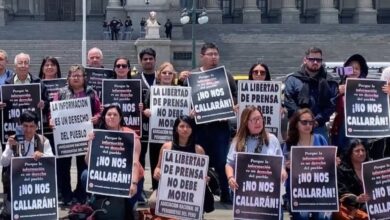Mexican Corridos: Ceasing Violence Needn’t Silence Artistic Expression

Concert chaos in Texcoco, just outside Mexico City, rekindled debate over banning narcocorridos when singer Luis R. Conriquez obeyed a local ordinance forbidding such music. While curtailing violence is a pressing concern, restricting individual freedom, particularly artistic expression, remains a worrying solution.
When Violence Meets Censorship
The recent uproar in Texcoco, where furious fans trashed a venue after Conriquez refused to perform narcocorridos, illustrates just how polarizing these prohibitions have become. On April 9, local authorities in Texcoco joined nine other Mexican states in banning corridos that celebrate or “glorify violence,” effectively silencing large sections of the regional Mexicano repertoire. Conriquez—widely credited as a pioneer of corridos bélicos— found himself in the crosshairs: His performance ended in disarray when he took a principled stand to comply with the new rules, prompting an angry reaction.
Narcocorridos and related subgenres like corridos tumbados and corridos verdes often reference real-world figures from the nation’s drug cartels. Some disapprove of those songs, claiming they approve of violent or unlawful acts. The increase in murders plus gang violence in Mexico is factual, but blaming music avoids attention to deeper problems in society. Fear, frustration, and moral panic may drive local officials to enact bans. Still, censorship does not address the underlying economic hardships, weak public institutions, or systemic injustices that foster the very violence these songs purportedly “glorify.”
It is also important to note that not all corridos revolve around drugs or outlaws. Government rules create danger. They may ruin a core component of Mexican culture by treating all corridos the same. Corridos began in the early 1900s. They documented the Mexican Revolution and common rural experiences. They tell tales of hardship and bravery, along with getting by. They can contain harsh or rebellious attitudes. A ban on violent themes can quickly morph into a broad-brushed prohibition that chills legitimate storytelling.
The Cultural Roots of Corridos
Historically, corridos functioned much like newspapers for rural communities—conveying news and reflecting social realities in a society where literacy was once scarce. Over generations, these ballads evolved to encompass everything from heartbreak and romance to local legends and heroic feats. Not surprisingly, as organized crime tightened its grip in certain regions, corridos emerged that recounted the exploits of cartel kingpins.
Some critics claim these “narco ballads” perpetuate a criminal mystique, especially for young listeners. Yet corridos themselves did not create cartels or the rampant insecurity plaguing many states. Just as gangster rap in the United States drew on real and often brutal urban struggles, narcocorridos reflect existing problems rather than magically conjuring them.
Indeed, freedom of expression should allow artists to document, critique, or sensationalize what happens around them. Efforts by local governments to muzzle these songs might appear prudent on the surface, but they open the door to broader limitations on speech. Rafael Valle, programming director for Guadalajara’s La Ke Buena radio station, told Billboard in 2024, “Music reflects what happens every day in our environment.” He stated that explicit mentions of unlawful drugs or aggressive behaviors require careful handling. However, denying access to commonly liked musical pieces that talk about actual problems borders on suppression of speech, perhaps causing new bitterness plus causing secret showings.
Banning music can steal more fascination, not less. When authorities forbid artists like Los Tigres del Norte or Luis R Conriquez from taking the stage, streaming numbers for their tracks tend to spike. Officials can unintentionally make these ballads more alluring by trying to stamp out “offensive” content. Thus, bans become the best publicity for the music they are meant to suppress.
Preserving Freedoms Through Dialogue
Mexico has a severe problem with violence. It divides communities. Political leaders plus police must respond firmly. The disorder at Conriquez’s Texcoco concert, which ended with property destruction, shows the audience feel emotions for narcocorridos. However, we must distinguish between violence and the artistic expressions that occasionally depict it.
Music—and all forms of creative output—has long served as a mirror and a megaphone of social realities. Erasing lyrics will not eradicate poverty or dismantle cartels. It also risks setting a dangerous precedent: If certain forms of art or speech become punishable purely due to their subject matter, where does it end? It might be narcocorridos; tomorrow, it could be political critiques or protest songs.
A beneficial strategy is to encourage conversation among musicians, community representatives, and local groups. Rather than penalizing artists, officials can involve them in public education. This education would spread awareness of the suffering caused by organized crime. Like films that show violence plus have ratings or age limits, radio companies and concert promoters could label performances appropriately instead of forbidding them entirely. Audiences can determine if they want to go once they know what they will hear.
The government, besides good public programs, must tackle violence. Drug trade grows in areas where poverty and dishonesty are more common than opportunity. This significant problem needs more than only penalizing artists. As recent events show, punishing musicians might placate a few officials seeking quick fixes, but it does little to heal the deep wounds of a nation caught between cartels and timid bureaucracy.
Though sometimes brutal in their depictions, Mexico’s corridos are an undeniable component of a living, breathing cultural tapestry. Rather than reflexively outlawing them, it may serve Mexico better to celebrate its rich storytelling tradition while recognizing the need for meaningful action to combat violence at its roots. If music is a mirror of society, then fracturing that mirror will not eliminate what it reflects. Instead, the cracks only obscure our view of the truth.
Also Read: Blood, Feathers, and Pride: Latin America’s Cockfighting Culture
Balancing public safety with freedom of expression is never simple. But imposing bans on entire genres is not the answer. By choosing authentic engagement and tackling underlying causes of crime, Mexico can confront violence without sacrificing artistic freedom—a key pillar of any vibrant, democratic society.





